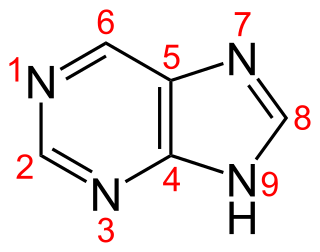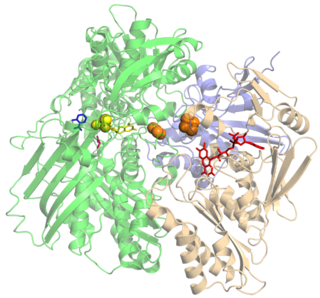Related Research Articles

Purine is a heterocyclic aromatic organic compound that consists of two rings fused together. It is water-soluble. Purine also gives its name to the wider class of molecules, purines, which include substituted purines and their tautomers. They are the most widely occurring nitrogen-containing heterocycles in nature.

Uric acid is a heterocyclic compound of carbon, nitrogen, oxygen, and hydrogen with the formula C5H4N4O3. It forms ions and salts known as urates and acid urates, such as ammonium acid urate. Uric acid is a product of the metabolic breakdown of purine nucleotides, and it is a normal component of urine. High blood concentrations of uric acid can lead to gout and are associated with other medical conditions, including diabetes and the formation of ammonium acid urate kidney stones.

Gout is a form of inflammatory arthritis characterized by recurrent attacks of a red, tender, hot and swollen joint, caused by the deposition of needle-like crystals of uric acid known as monosodium urate crystals. Pain typically comes on rapidly, reaching maximal intensity in less than 12 hours. The joint at the base of the big toe is affected (Podagra) in about half of cases. It may also result in tophi, kidney stones, or kidney damage.

Xanthine oxidase is a form of xanthine oxidoreductase, a type of enzyme that generates reactive oxygen species. These enzymes catalyze the oxidation of hypoxanthine to xanthine and can further catalyze the oxidation of xanthine to uric acid. These enzymes play an important role in the catabolism of purines in some species, including humans.

Allopurinol is a medication used to decrease high blood uric acid levels. It is specifically used to prevent gout, prevent specific types of kidney stones and for the high uric acid levels that can occur with chemotherapy. It is taken orally or intravenously.

Hyperuricaemia or hyperuricemia is an abnormally high level of uric acid in the blood. In the pH conditions of body fluid, uric acid exists largely as urate, the ion form. Serum uric acid concentrations greater than 6 mg/dL for females, 7 mg/dL for men, and 5.5 mg/dL for youth are defined as hyperuricemia. The amount of urate in the body depends on the balance between the amount of purines eaten in food, the amount of urate synthesised within the body, and the amount of urate that is excreted in urine or through the gastrointestinal tract. Hyperuricemia may be the result of increased production of uric acid, decreased excretion of uric acid, or both increased production and reduced excretion.
Tumor lysis syndrome (TLS) is a group of metabolic abnormalities that can occur as a complication from the treatment of cancer, where large amounts of tumor cells are killed off (lysed) from the treatment, releasing their contents into the bloodstream. This occurs most commonly after the treatment of lymphomas and leukemias and in particular when treating non-Hodgkin lymphoma, acute myeloid leukemia, and acute lymphoblastic leukemia. This is a potentially fatal complication and patients at increased risk for TLS should be closely monitored while receiving chemotherapy and should receive preventive measures and treatments as necessary. TLS can also occur on its own although this is less common.

The enzyme urate oxidase (UO), uricase or factor-independent urate hydroxylase, absent in humans, catalyzes the oxidation of uric acid to 5-hydroxyisourate:

Lesch–Nyhan syndrome (LNS) is a rare inherited disorder caused by a deficiency of the enzyme hypoxanthine-guanine phosphoribosyltransferase (HGPRT). This deficiency occurs due to mutations in the HPRT1 gene located on the X chromosome. LNS affects about 1 in 380,000 live births. The disorder was first recognized and clinically characterized by American medical student Michael Lesch and his mentor, pediatrician William Nyhan, at Johns Hopkins.

Rasburicase is a medication that helps to clear uric acid from the blood. It is a recombinant version of urate oxidase, an enzyme that metabolizes uric acid to allantoin. Urate oxidase is known to be present in many mammals but does not naturally occur in humans. Rasburicase is produced by a genetically modified Saccharomyces cerevisiae strain. The complementary DNA (cDNA) coding for rasburicase was cloned from a strain of Aspergillus flavus.

Hypouricemia or hypouricaemia is a level of uric acid in blood serum that is below normal. In humans, the normal range of this blood component has a lower threshold set variously in the range of 2 mg/dL to 4 mg/dL, while the upper threshold is 530 μmol/L (6 mg/dL) for women and 619 μmol/L (7 mg/dL) for men. Hypouricemia usually is benign and sometimes is a sign of a medical condition.
Purine metabolism refers to the metabolic pathways to synthesize and break down purines that are present in many organisms.

Febuxostat, sold under the brand names Uloric and Adenuric among others, is a medication used long-term to treat gout due to high uric acid levels. It is generally recommended only for people who cannot take allopurinol. When initially started, medications such as NSAIDs are often recommended to prevent gout flares. It is taken by mouth.

Hyperuricosuria is a medical term referring to the presence of excessive amounts of uric acid in the urine. For men this is at a rate greater than 800 mg/day, and for women, 750 mg/day. Notable direct causes of hyperuricosuria are dissolution of uric acid crystals in the kidneys or urinary bladder, and hyperuricemia. Notable indirect causes include uricosuric drugs, rapid breakdown of bodily tissues containing large quantities of DNA and RNA, and a diet high in purine.

Benzbromarone is a uricosuric agent and non-competitive inhibitor of xanthine oxidase used in the treatment of gout, especially when allopurinol, a first-line treatment, fails or produces intolerable adverse effects. It is structurally related to the antiarrhythmic amiodarone.

Cinnamomum osmophloeum, commonly known as pseudocinnamomum or indigenous cinnamon, is a medium-sized evergreen tree in the genus Cinnamomum. It is native to broad-leaved forests of central and northern Taiwan.

Oxipurinol is an inhibitor of xanthine oxidase. It is an active metabolite of allopurinol and it is cleared renally. In cases of renal disease, this metabolite will accumulate to toxic levels. By inhibiting xanthine oxidase, it reduces uric acid production. High serum uric acid levels may result in gout, kidney stones, and other medical conditions.
Sān miào wán is a traditional Chinese medicine consisting of three components:

Lesinurad is a urate transporter inhibitor for treating high blood uric acid levels associated with gout. It is recommended only as an adjuvant with either allopurinol or febuxostat when these medications are not sufficient.

Ruzinurad (SHR4640) is a selective urate transporter 1 (URAT1) inhibitor in development for hyperuricaemia and gout. It is developed by Jiangsu Hengrui.
References
- ↑ Pacher P, Nivorozhkin A, Szabó C (March 2006). "Therapeutic Effects of Xanthine Oxidase Inhibitors: Renaissance Half a Century after the Discovery of Allopurinol". Pharmacol. Rev. 58 (1): 87–114. doi:10.1124/pr.58.1.6. PMC 2233605 . PMID 16507884.
- ↑ Iwanaga T, Kobayashi D, Hirayama M, Maeda T, Tamai I (December 2005). "Involvement of uric acid transporter in increased renal clearance of the xanthine oxidase inhibitor oxypurinol induced by a uricosuric agent, benzbromarone". Drug Metabolism and Disposition. 33 (12): 1791–5. doi:10.1124/dmd.105.006056. PMID 16135657. S2CID 16377221.
- ↑ Becker MA, Schumacher HR, Wortmann RL, et al. (March 2005). "Febuxostat, a novel nonpurine selective inhibitor of xanthine oxidase: a twenty-eight-day, multicenter, phase II, randomized, double-blind, placebo-controlled, dose-response clinical trial examining safety and efficacy in patients with gout". Arthritis and Rheumatism. 52 (3): 916–23. doi:10.1002/art.20935. PMID 15751090.
- ↑ Procházková D, Boušová I, Wilhelmová N (2011). "Antioxidant and prooxidant properties of flavonoids". Fitoterapia . 82 (4): 513–523. doi:10.1016/j.fitote.2011.01.018. PMID 21277359.
- ↑ Selloum L, Reichl S, Müller M, Sebihi L, Arnhold J (November 2001). "Effects of flavonols on the generation of superoxide anion radicals by xanthine oxidase and stimulated neutrophils". Archives of Biochemistry and Biophysics. 395 (1): 49–56. doi:10.1006/abbi.2001.2562. PMID 11673865.
- ↑ Nagao A, Seki M, Kobayashi H (October 1999). "Inhibition of xanthine oxidase by flavonoids". Bioscience, Biotechnology, and Biochemistry. 63 (10): 1787–90. doi: 10.1271/bbb.63.1787 . PMID 10671036.
- ↑ Wang SY, Yang CW, Liao JW, Zhen WW, Chu FH, Chang ST (August 2008). "Essential oil from leaves of Cinnamomum osmophloeum acts as a xanthine oxidase inhibitor and reduces the serum uric acid levels in oxonate-induced mice" (PDF). Phytomedicine. 15 (11): 940–5. doi:10.1016/j.phymed.2008.06.002. PMID 18693097.
- ↑ Yoshizumi K, Nishioka N, Tsuji T (March 2005). "プロポリスのキサンチンオキシダーゼ活性阻害作用及び血漿尿酸値低下作用 [Xanthine oxidase inhibitory activity and hypouricemia effect of propolis in rats]". Yakugaku Zasshi (in Japanese). 125 (3): 315–21. doi: 10.1248/yakushi.125.315 . PMID 15738631.
- ↑ Ahmad NS, Farman M, Najmi MH, Mian KB, Hasan A (May 2008). "Pharmacological basis for use of Pistacia integerrima leaves in hyperuricemia and gout". J Ethnopharmacol. 117 (3): 478–82. doi:10.1016/j.jep.2008.02.031. PMID 18420362.
- ↑ Chiang HC, Lo YJ, Lu FJ (1994). "Xanthine oxidase inhibitors from the leaves of Alsophila spinulosa (Hook) Tryon". Journal of Enzyme Inhibition. 8 (1): 61–71. doi:10.3109/14756369409040777. PMID 7539070.